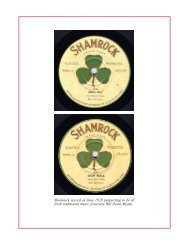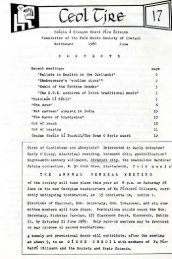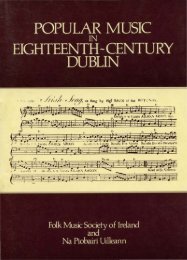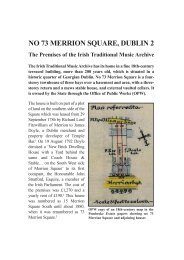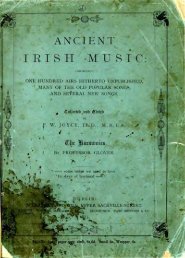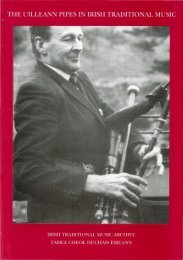Union Pipes - Irish Traditional Music Archive
Union Pipes - Irish Traditional Music Archive
Union Pipes - Irish Traditional Music Archive
Create successful ePaper yourself
Turn your PDF publications into a flip-book with our unique Google optimized e-Paper software.
COURTNEY’S ‘UNION PIPES’ AND THE TERMINOLOGY OF IRISH BELLOWS-BLOWN BAGPIPES 70<br />
flat and <strong>Irish</strong> union pipes’ in New York in 1817, 223 and Donald<br />
MacDonald, a ‘pipe maker’ and publisher of Highland pipe music,<br />
advertised in Edinburgh about 1822 that he was teaching ‘Highland,<br />
Northumberland & <strong>Irish</strong> bagpipes’; he may also have been<br />
manufacturing them. 224<br />
<strong>Irish</strong> professional players of the ‘union pipes’ began appearing in<br />
some numbers in the United States in the early nineteenth century,<br />
long after performers on the ‘<strong>Irish</strong> pipes’ had been recorded as<br />
appearing there in the eighteenth century. The first known is a ‘Mr.<br />
Curran, a celebrated performer, lately from Ireland’, who was<br />
playing ‘national airs’ on ‘union pipes’ in New York in February<br />
1808. 225 He was followed by, among others, a Mr Edward Reynolds,<br />
‘late from Dublin’ who was performing on the ‘<strong>Irish</strong> union pipes’ in<br />
Boston in March 1812; 226 and a Charles P.F. O’Hara, a multiinstrumentalist<br />
who had ‘resided many years in the west of Ireland’,<br />
and who published The Gentleman’s <strong>Music</strong>al Repository; being a<br />
selection from the ancient and modern music of Erin, and several<br />
original pieces by the compiler; adapted to the violin, flute,<br />
flageolet, hautboy and union pipes in New York in January 1813. 227<br />
Among these pipers, the instrument was most commonly called the<br />
‘<strong>Irish</strong> union pipes’; 228 they were, seemingly, signalling an ethnic<br />
connection to their audiences in a way that had not often happened in<br />
222<br />
Cheape 2008: 118 refers to undated ‘part-sets and chanters for the <strong>Union</strong><br />
Pipe’ by makers Nicholas Kerr of Edinburgh, and ‘Dunn, Bannon, Massie, Scott<br />
and Weldon’ which were acquired by the National Museum of Scotland from an<br />
Edinburgh source. For Kerr (d. 1773 – Sanger, research notes) of Edinburgh &<br />
Massie of Aberdeen see Campbell 2011: 4 & 30. For other possible makers, see<br />
Walstrom 2002: 2.15/ 1–4.<br />
223<br />
Carolan 2011: 2, 22–5.<br />
224<br />
Cannon 1980: 12, 118–20.<br />
225<br />
Evening Post, New York, 11 Feb. 1808.<br />
226<br />
Columbian Centinel, Boston, 22 Feb. 1812.<br />
227<br />
Columbian, New York, 2 Jan. 1813.<br />
228<br />
See Carolan 2011: 22–5.



